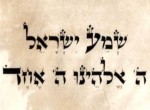The Shema: not as easy as we thought – Va’et’channan
 The Shema accompanies us through life. It is the first Jewish expression of hesitant childhood, and the final affirmation of Judaism at the moment of death.
The Shema accompanies us through life. It is the first Jewish expression of hesitant childhood, and the final affirmation of Judaism at the moment of death.
Our Hebrew knowledge may be infinitesimal, but we can always recognise the ancient words of the Shema.
We may not be too certain about the nuances of its theology, but we know there is something precious beyond rubies in its unambiguous assertion that God is One.
However, BS Jacobson, author of the stimulating work, “Meditations on the Torah” (Binah BaMikra), draws our attention to the logical problems inherent in the famous first sentence, which says, “The Lord is our God, the Lord is One” (Deut. 6:4).
If, he says, God is one and universal, how can we claim Him as merely our God, the God of Israel, and by implication the God of no other people?
Jacobson cites a Midrash (Yalkut Shim’oni 833; cf. Mechilta on Ex. 23:17) that explains that this verse does not represent an exclusive possessive claim by Israel, but an indication of special responsibility: though God is universal, it is incumbent upon us particularly to stand for and profess the unity of His name.
Rashi, basing himself on the Sifrei, another ancient midrashic work, attempts to solve the problem by finding two stages in the verse: “The Lord is our God” speaks of the here and now, and “The Lord is One” speaks of the future.
“The Lord, who is now acknowledged only as our God and not the God of other peoples,” he says, “will in time to come be the One Lord”, and all peoples will know Him and call upon His name (Zeph. 3:9, Zech. 14:9).
Jacobson adds a fascinating additional interpretation proposed by Solomon Ephraim Lencziz, author of the popular commentary, K’li Yakar. Lencziz points out that the verse uses the two main Divine names, HaShem (“The Lord”) and Elokim (“God”).
Traditionally the first stands for the Divine attribute of mercy and the second the attribute of justice. But not until the end of history will the Almighty’s name be one (Zech. 14:9).
Lencziz quotes the Talmudic statement (P’sachim 50a) that this world and the World to Come are different: in this world a person who hears good news says, “Blessed be He who is good and does good” and on bad news, “Blessed be the True Judge”; in the World to Come one will always say, “Blessed be He who is good and does good”.
Rashi explains that in the World to Come there will be no bad news. Lencziz says that in today’s world many are overwhelmed by “bad news”. They see a conflict between the Divine mercy and justice, and turn away from God and religion.
In time to come, however, there will be no “bad news”; there will be no questioning of His judgment or rebellion against Him, and (as the High Holyday prayer, V’ye’etayu, puts it), “All the world will come to serve Him and bless His glorious name”.



